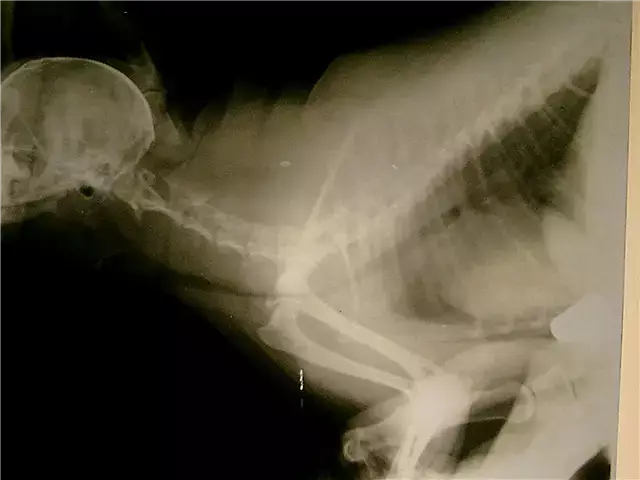- Author Rachel Wainwright [email protected].
- Public 2023-12-15 07:39.
- Last modified 2025-11-02 20:14.
Cyclodol
Instructions for use:
- 1. Pharmacological action
- 2. Release form
- 3. Indications for use
- 4. Contraindications
- 5. Method of administration and dosage
- 6. Side effects
- 7. Special instructions
- 8. Analogs
- 9. Storage conditions

Cyclodol belongs to the central H-anticholinergics. Included in the group of anticholinergics.
Pharmacological action of Cyclodol
Due to the ability to provide peripheral and central myelo-relaxant and anticholinergic actions, Cyclodol is one of the main drugs used in parkinsonism. The drug helps to reduce tremors, has little effect on bradykinesia and rigidity.
Due to the fact that Cyclodol has an M-anticholinergic effect on the peripheral nervous system, taking the drug helps to reduce sweating and salivation. Also, the drug is capable of exerting the effect of a local anesthetic. The total duration of the therapeutic effect after administration is from 6 to 12 hours, the maximum effect lasts from 2 to 3 hours. After oral administration of Cyclodol, the drug begins to actively act after 1 hour. When administered intramuscularly, this time is reduced to 10 minutes, and the effect can last until 12 noon
Release form
According to the instructions for Cyclodol, the only form of release of the drug are tablets with an active substance mass of 0.001, 0.002 or 0.005 g. The tablets are white, rounded, flat surface. Packed in a box in the amount of 50 pcs.
Indications for the use of Cyclodol
Medical reviews about Cyclodol describe the drug as an effective remedy for the following diseases of the nervous system:
- parkinsonism of various origins;
- disorders of the extrapyramidal system, which are accompanied by increased muscle tone and the presence of hyperkinesis (violent automatic movements caused by involuntary muscle contractions).
Contraindications
Cyclodol and analogues of the drug are potent substances. In this regard, their use is not recommended for admission in some cases. You should not use the drug if:
- there is a hypersensitivity to the components of the drug, in particular to trihexyphenidil;
- the patient suffers from urinary retention;
- diagnosed with adenoma (prostatic hypertrophy) with the presence of urine residues;
- there are diseases of the gastrointestinal tract of an obstructive nature;
- diagnosed with atrial fibrillation;
- the patient is less than 5 years old;
- there is a confirmed pregnancy.
Method of administration and dosage
The instruction for Cyclodol recommends starting taking the drug with the minimum allowed doses, which are then gradually increased, if necessary and under the supervision of a doctor. Minimum doses vary depending on the type of disease.
- In Parkinson's syndrome, it is recommended to start taking the drug with 1 mg of trihexyphenidil hydrochloride (the main active ingredient of Cyclodol) per day. If necessary, the dose is increased to a maximum of 3 mg every 3-5 days. One should focus on the patient's condition and the achievement of the optimal effect of treatment. The maintenance dose for this disease reaches 16 mg per day, the lower bar is 6 mg. It is necessary to distribute this amount for 3-5 receptions. It should also be noted that taking Cyclodol in doses exceeding 20 mg per day is not recommended.
- For extrapyramidal disorders, take up to 16 mg of the drug per day (lower bar - 2 mg). The dosage is selected depending on the severity of the symptoms. The maximum permitted dose is also 20 mg.
- With anticholinergic therapy, the dose of the drug should be adjusted smoothly, every day increasing the initial dose (2 mg) to the minimum effective maintenance dose. In this case, the maximum allowable amount is 50 mg per day.
- For the treatment of children and adolescents aged 5 to 17 years, Cyclodol is prescribed only as a therapy for extrapyramidal dystonia. The maximum allowable dose should not be higher than 40 mg per day.

General recommendations for taking Cyclodol: tablets should be consumed regardless of food intake, washed down with a sufficient amount of liquid (about 180 ml). If, before starting treatment, the patient experienced hypersalivation (increased salivation), Cyclodol is best taken after meals. During treatment with the drug, dryness in the mouth may occur. In this case, Cyclodol must be taken before meals, controlling the occurrence of nausea.
The drug should not be canceled abruptly, treatment requires gradual completion, in which the dosage is gradually reduced over 1-2 weeks. If these recommendations are not followed, the symptoms of the disease may worsen.
The duration of treatment is determined exclusively by the doctor in the specific case of the disease.
Side effects of Cyclodol
According to medical reviews about Cyclodol, the drug is able to affect various organ systems, causing unwanted reactions. If you find the symptoms described below, it is recommended to consult a doctor:
- violation of accommodation, headache, irritability, drowsiness, vomiting, nausea. In rare cases, symptoms of increased anxiety, impaired memory, consciousness and sleep may occur. Even less often - dyskinesia (involuntary movements);
- dryness in the mouth, constipation, decreased sweating, impaired urination, tachycardia. Less commonly - mydriasis, bradycardia, visual impairment;
- allergic skin rashes.
As a rule, the symptoms go away on their own, or are eliminated by reducing the dose or frequency of administration.
special instructions
The use of Cyclodol and analogues of the drug by patients over 60 years old should be accompanied by constant medical supervision due to the high likelihood of impairment of thinking and memory during administration.
Control of intraocular pressure during treatment with Cyclodol is required.
When taking the drug, drug dependence may develop.
The use of high doses, overdose can cause the appearance of hallucinations, delirium, disorientation in time and space.
Care must be taken when driving vehicles and performing other potentially dangerous activities during the period of treatment with Cyclodol.
Cyclodol's analogs
The drugs that have similar properties to Cyclodol include the following drugs:
- Parkopan;
- Tremin;
- Antitrem;
- Benzhexol hydrochloride;
- Parkinsan;
- Pacitan;
- Trixil et al.
Storage conditions of Cyclodol
It is imperative to protect Cyclodol from the access of children. The drug is stored in a dry place, away from sunlight, where the temperature is no higher than 25 ° C. The shelf life under the storage conditions is 5 years.
Information about the drug is generalized, provided for informational purposes only and does not replace the official instructions. Self-medication is hazardous to health!






